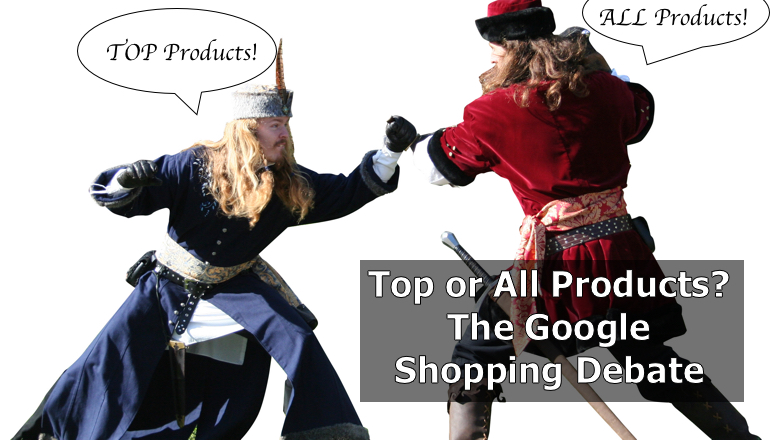I’ve heard this question before, the most recent being on Twitter from Sam Gordon:
Do any of you only include only top products in your shopping feed, instead of all products? Wanting my most relevant ads to show #ppcchat
— Sam Gordon (@SamGordonPPC) February 9, 2015
My answer to this (and the others like it) is: “it depends”.
Don’t stone me yet for that ridiculously annoying, yet applicable automated PPC response. Let me explain.
The Case for All Products
At some level, you are going to want all of your client’s products on Google Shopping. I am often surprised by a product that’s not a best-seller that still performs great on Google Shopping. Since all the factors of PPC come into play here, bid, competition, search volume, etc, it’s possible for a product to perform well on Google Shopping even though it’s not a go-to for all of your organic and referral (and maybe even traditional PPC text ad) customers.
You wouldn’t find out about this product if you left it out of the feed. So, at some level, I’m an All Products guy.
While I was talking with Sam Gordon about his question, I noticed the venerable Andrew Bethel going through a lot of the same details. I liked what he had to say about this:
@SamGordonPPC Yeah, I’ve found that I am usually surprised by the top products from PLAs vs Full Site vs Online & Offline.
— Andrew Bethel (@AndrewPPC) February 9, 2015
The Case for Top Products Only
However, as is great practice with normal PPC, why spend your budget, time, and energy on lots of products you don’t know will convert. Here are times I think it’s legitimate to just focus on Top Products.
- Your client has an abundance (read: ridiculous amount) of products. I’ve noticed this especially with “parts” clients. There can be tens of thousands of products. Releasing the hounds in this case can rapidly spread your budget/cost over such a broad range of products that it can be difficult to maintain profitability.
- You have a limited budget. It may be that your client is just interested in “testing” Google Shopping or for whatever reason just doesn’t want to give more budget. In this case, it would be wise to focus only on those products proven to convert in the long-run. Once you’ve established profitability, take this to your client for increased budget so you can advertise all products.
- You have limited feed optimization ability/time. This somewhat nestles under point one, but focusing on just the overall Top Performers allows you to really hit them hard and well. Instead of putting time into feed optimization for thousands of products, you’re taking that time and spending even more resources on those Top Performers.
- There is a significant separation between the Top Products and “all the rest”. A final thought in considering your strategy is to ask whether there are obvious leaders of the pack that can be focused on. If your client has 20 products that sell at 6x the rate of all the others, and they are all supplementary then perhaps this is a good indication of where to invest your time.
Get Your Cake (And Eat It Too)
“The only one of the above points that would actually prevent me from investing any time/spend into All Products would be “limited budget.”
In my opinion, the only one of the above points that would actually prevent me from investing any time/spend into All Products would be limited budget. If a client gives you a severely limited budget, than it’s probably not wise to spend it on thousands of products. Rather take that budget and devote it to your Top Products until you can use that profitability to request a budget raise.
For all the others, I believe there is a solution where you can actually have All Products running, yet also focus on the Top Products. In other words, you really can have your cake eat and it too!
(2) Utilize your other Shopping Strategy for all the rest at lower priority levels.
(1) Create a Top Products campaign. The benefit of doing this is:
- You can split individual products into specific ad groups which allows you to utilize negative keywords for traffic guiding. If this is a new concept to you, I wrote on this idea of using negative keywords to direct traffic previously here: Negative Keywords: Stop (Only) Excluding, Start Directing! BE WARNED, Shopping is different from normal Search because multiple ads can appear for the same query! Therefore, don’t go so crazy on negative keywords that you begin preventing yourself from multiple placements.
- The higher priority level of the campaign means all queries are running through it first so your Top Products are getting first dibs on queries.
- Keeping this campaign separate allows you to better control bidding and budget for those Top Products.
- Keeping this campaign separate allows you to keep a laser-focus on those Top Products (at least, the ones that “should” be converting well) since each is in its own separate (and well-named for quicker optimization!) ad group.
(2) Utilize your other Shopping Strategy for all the rest at lower priority levels.
The purpose of the “all products” strategy is to focus more on the searches/customers/conversions you didn’t know about!
Now that you have your Top Products campaign running, take one of the many strategies out there and apply it here. The key is to keep your campaign priority level at Low or Medium. Since you have two more levels, you can still utilize these other methods in their own strategies! This also allows you to keep bids much lower on the rest of your products than normal because your top products are already showing in your Top Products campaign for the most relevant, highest competition, likely to convert terms.
The purpose of the “all products” strategy is to focus more on the searches/customers/conversions you didn’t know about! Often, this means your competition “didn’t know about them” either and you can pick up some great, low CPA conversions.
Because this has been covered so well in other places, I will do no more than point you to a couple of places:
- Martin Roettgerding’s tell-all where he gives his secret brand strategy: Taking Google Shopping to the Next Level.
- Amy Bishop’s summary of the most common strategies: Organizing Products Into Shopping Campaigns
Final Thoughts
In conclusion, unless you are significantly hampered by budget, it nearly always make sense to run both Top Products and All Products in your Shopping campaigns as long as you follow a strategy that emphasizes the Top Products.
What about you? Anything helpful you would add to further the conversation?




